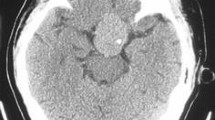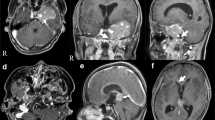Abstract
The development of an esthesioneuroblastoma outside to the region in which olfactory epithelium exists is extremely rare. Only nine cases were reported in the previous literatures. The author presents a 40 years-old man with ectopic esthesioneuroblastoma in sella turcica. In contrast to the previous nine cases, our case presented unusual presentations—CSF rhinorrhea and meningitis. Endoscopic transphenoid approach with removal of tumor and repair of dura defect followed by radiotherapy offered a good result in this case. Moreover, differential diagnosis and the origin of the ectopic esthsioneuroblastoma would be discussed.




Similar content being viewed by others
References
Berger L, Luc R (1924) Esthioneuroepitheliome olfactif. Bull Assoc Fr Etud Cancer 3:410–421
Mc CL, Harris HE (1955) Neurogenic tumors of the nasal fossa. J Am Med Assoc 157(4):318–321
Svane-Kundsen V, Jorgensen KE, Hansen O (1998) Cancer of the nasal cavity and paranasal sinuses: a series of 115 patients. Rhinology 36:2–14
Morris L, Govindaraj S, Genden EM (2004) Primary sphenoid sinus esthesioneuroblastoma. Am J Otolaryngol 25(5):350–353
Sarwar M (1979) Primary sellar-parasellar esthesioneuroblastoma. AJR Am J Roentgenol 133(1):140–141
Roy A et al (2000) Correspondence: aesthesioneuroblastoma arising in pituitary gland. Neuropathol Appl Neurobiol 26(2):177–179
Mariani L et al (2004) Esthesioneuroblastoma of the pituitary gland: a clinicopathological entity? Case report and review of the literature. J Neurosurg 101(6):1049–1052
Sajko T et al (2005) Primary sellar esthesioneuroblastoma. Acta Neurochir (Wien) 147(4):447–448; discussion 448
Sharma SC et al (2002) Isolated esthesioneuroblastoma of sphenoid sinus. Am J Otolaryngol 23(5):287–289
Chacko G, Chandi SM, Chandy MJ (1998) Primary sphenoid and petrous apex esthesioneuroblastoma: case report. Br J Neurosurg 12(3):264–266
Chirico G et al (2003) Primary sphenoid esthesioneuroblastoma studied with MR. Clin Imaging 27(1):38–40
Martin TJ et al (2002) Evaluation and surgical management of isolated sphenoid sinus disease. Arch Otolaryngol Head Neck Surg 128(12):1413–1419
Daryl R, Fourney FD (1996) Neoplasms of the paranasal sinuses. In: Winn H, Richard Y, Julian R (eds) Yuomans neurological surgery, 4th edn. pp. 1311–1331
Jakumeit HD (1971) Neuroblastoma of the olfactory nerve. Acta Neurochir (Wien) 25(1):99–108
Wirsig-Wiechmann CR, Oka Y (2002) The terminal nerve ganglion cells project to the olfactory mucosa in the dwarf gourami. Neurosci Res 44(3):337–341
Wirsig-Wiechmann CR, Wiechmann AF, Eisthen HL (2002) What defines the nervus terminalis? Neurochemical, developmental, and anatomical criteria. Prog Brain Res 141:45–58
Zappia JJ et al (1992) Olfactory neuroblastoma associated with Kallman’s syndrome. J Otolaryngol 21(1):16–9
Kim DW et al (2004) Neoadjuvant etoposide, ifosfamide, and cisplatin for the treatment of olfactory neuroblastoma. Cancer 101(10):2257–2260
Lund VJ et al (2003) Olfactory neuroblastoma: past, present, and future? Laryngoscope 113(3):502–507
Unger F et al (2005) Combined endoscopic surgery and radiosurgery as treatment modality for olfactory neuroblastoma (esthesioneuroblastoma). Acta Neurochir (Wien) 147(6):595–601; discussion 601–2
Ebersold MJ, Olsen KD, Foote RL, et al (1997) Esthesioneuroblastoma. In: Kaye AH, Laws ER (eds) Brain tumors. Edinburgh, Churchill Livingstone, pp 825–838
Ghaffar S, Salahuddin I (2005) Olfactory neuroblastoma: a case report and review of the literature. Ear Nose Throat J 84(3):150–152
Eich HT et al (2003) Multimodality therapy including radiotherapy and chemotherapy improves event-free survival in stage C esthesioneuroblastoma. Strahlenther Onkol 179(4):233–240
Author information
Authors and Affiliations
Corresponding author
Rights and permissions
About this article
Cite this article
Lin, JH., Tsai, DH. & Chiang, YH. A primary sellar esthesioneuroblastomas with unusual presentations: a case report and reviews of literatures. Pituitary 12, 70–75 (2009). https://doi.org/10.1007/s11102-007-0081-3
Published:
Issue Date:
DOI: https://doi.org/10.1007/s11102-007-0081-3




